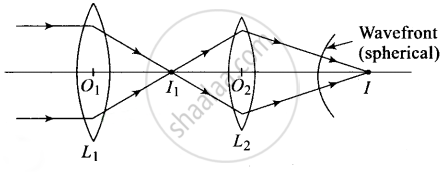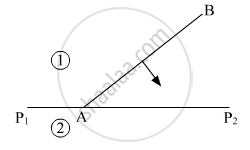Advertisements
Advertisements
प्रश्न
Consider a point at the focal point of a convergent lens. Another convergent lens of short focal length is placed on the other side. What is the nature of the wavefronts emerging from the final image?
उत्तर
Orientation of wavefront is perpendicular to ray. The ray diagram of the situation is shown in figure.

Parallel rays incident on lens L1 forms the image I2 at the focal point of the lens. This image acts as object for the lens L2 Now, due to the converging lens L2 , let final image formed is I which is point image. Hence the wavefront for this image will be of spherical symmetry.
APPEARS IN
संबंधित प्रश्न
Using Huygens's construction of secondary wavelets explain how a diffraction pattern is obtained on a screen due to a narrow slit on which a monochromatic beam of light is incident normally.
You have learnt in the text how Huygens’ principle leads to the laws of reflection and refraction. Use the same principle to deduce directly that a point object placed in front of a plane mirror produces a virtual image whose distance from the mirror is equal to the object distance from the mirror.
Using Huygens’ principle, verify the laws of reflection at a plane surface.
Huygens' principle of secondary wavelets may be used to
(a) find the velocity of light in vacuum
(b) explain the particle behaviour of light
(c) find the new position of a wavefront
(d) explain Snell's Law
Derive the law of reflection using Huygen’s Wave Theory.
With what type of source of light are cylindrical wave fronts associated?
Define the term 'wavefront of light'. A plane wavefront AB propagating from a denser medium (1) into a rarer medium (2) is incident of the surface P1P2 separating the two media as shown in fig.
Using Huygen's principle, draw the secondary wavelets and obtain the refracted wavefront in the diagram.

The inverse square law of intensity is valid for a
Is Huygen’s principle valid for longitudinal sound waves?
Represent diagrammatically how the incident planar wavefronts of wavelength λ pass through an aperture of size d, when d is approximately equal to λ.
